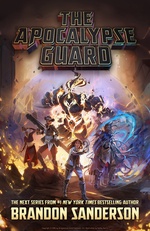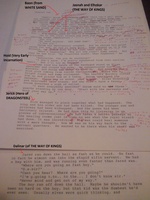Brandon Sanderson
As I was developing the Cosmere, I knew I wanted a few threads to span the entire mega-sequence, which was going to cover thousands of years. For this reason, I built into the outline a couple of "core" series.
One of these is the Stormlight Archive, where we have the Heralds who span ages, and which I eventually decided to break into two distinct arcs. Other series touch on the idea of long-standing characters. Dragonsteel, for example, will be kind of a bookend series. We'll get novels on Hoid's origins, then jump all the way to the end and get novels from his viewpoint late in the entire Cosmere sequence.
With Mistborn, I wanted to do something different. For aesthetic reasons, I wanted a fantasy world that changed, that grew updated and modernized. One of my personal mandates as a lover of the epic fantasy genre is to try to take what has been done before and push the stories in directions I think the genre hasn't looked at often enough.
I pitched Mistorn as a series of trilogies, which many of you probably already know. Each series was to cover a different era in the world (Scadrial), and each was to be about different characters—starting with an epic fantasy trilogy, expanding eventually into a space opera science fiction series. The magic would be the common thread here, rather than specific characters.
There was a greater purpose to this, more than just wanting a fantasy world that modernized. The point was to actually show the passage of time in the universe, and to make you, the reader, feel the weight of that passage.
Some of the Cosmere characters, like Hoid, are functionally immortal—in that, at least, they don't age and are rather difficult to kill. I felt that when readers approached a grand epic where none of the characters changed, the experience would be lacking something. I could tell you things were changing, but if there were always the same characters, it wouldn't feel like the universe was aging.
I think you get this problem already in some big epic series. (More on that below.) Here, I wanted the Cosmere to evoke a sense of moving through eras. There will be some continuing threads. (A few characters from Mistborn will be weaved through the entire thing.) However, to make this all work, I decided I needed to do something daring—I needed to reboot the Mistborn world periodically with new characters and new settings.
So how does Shadows of Self fit into this entire framework? Well, The Alloy of Law was (kind of) an accident. It wasn't planned to be part of the original sequence of Mistborn sub-series, but it's also an excellent example of why you shouldn't feel too married to an outline.
As I was working on Stormlight, I realized that it was going to be a long time (perhaps ten years) between The Hero of Ages and my ability to get back to the Mistborn world to do the first of the "second" series. I sat down to write a short story as a means of offering a stop-gap, but was disappointed with it.
That's when I took a step back and asked myself how I really wanted to approach all of this. What I decided upon was that I wanted a new Mistborn series that acted as a counterpoint to Stormlight. Something for Mistborn fans that pulled out some of the core concepts of the series (Allomantic action, heist stories) and mashed them with another genre—as opposed to epic fantasy—to produce something that would be faster-paced than Stormlight, and also tighter in focus.
That way, I could alternate big epics and tight, action character stories. I could keep Mistborn alive in people's minds while I labored on Stormlight.
The Alloy of Law was the result, an experiment in a second-era Mistborn series between the first two planned trilogies. The first book wasn't truly accidental, then, nor did it come from a short story. (I've seen both reported, and have tacitly perpetuated the idea, as it's easier than explaining the entire process.) I chose early 20th century because it's a time period I find fascinating, and was intrigued by the idea of the little-city lawman pulled into big-city politics.
Alloy wasn't an accident, but it was an experiment. I wasn't certain how readers would respond to not only a soft reboot like this, but also one that changed tone (from epic to focused). Was it too much?
The results have been fantastic, I'm happy to report. The Alloy of Law is consistently the bestselling book in my backlists, barring the original trilogy or Stormlight books. Fan reaction in person was enthusiastic.
So I sat down and plotted a proper trilogy with Wax and Wayne. That trilogy starts with Shadows of Self. It connects to The Alloy of Law directly, but is more intentional in where it is taking the characters, pointed toward a three-book arc.
You can see why this is sometimes hard to explain. What is Shadows of Self? It's the start of a trilogy within a series that comes after a one-off with the same characters that was in turn a sequel to an original trilogy with different characters.


